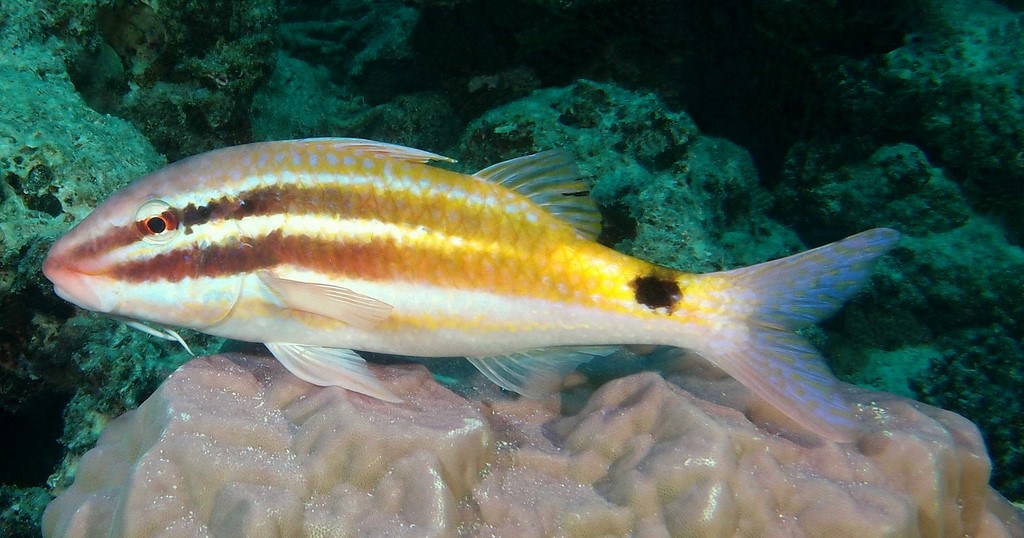PARUPENEUS SPILURUS - (BLEEKER, 1854)
Actinopterygii (Gigaclass) > Actinopteri (Class) > Teleostei (Subclass) > Syngnathiformes (Order) > Mulloidei (Suborder) > Mullidae (Family) > Parupeneus (Genus)
Rouget-barbet à tache noire, Rouget-barbet à bandes marron, Black-spot goat fish, Blacksaddle goatfish, Blackspot goatfish, Northern kahawai, One-spot goatfish, Red goatfish, Tailspot goatfish, Japanische Meerbarbe, Okina-himeji, オキナヒメジ, 두줄촉수, 大型海緋鯉,
Synonymes
Papupeneus spilurus (Bleeker, 1854)
Parupeneus signatus (Günther, 1867)
Pseudupeneus jeffi (Ogilby, 1908)
Upeneus signatus (Günther, 1867)
Upeneus spilurus (Bleeker, 1854)
--------------------------
Description
Dorsal spines (total): 8; Dorsal soft rays (total): 9; Anal spine: 1; Anal soft rays: 7; Pectoral fin rays: 15-17 (usually: 16); Gill rakers: 28-32; Body depth: 3.1-3.5in SL; Snout: 1.85-2.25 in HL; Barbels: 1.35-1.65 in HL. Max length: 50.0 cm. Depth range: 10 - 80 m.
Color
A dark brown band, broadly bordered on each side by a white to pale red band, passing from front of snout through eye to rear base of second dorsal fin; A second dark band paralleling the first beginning at comer of mouth (brown bands often brownish yellow posteriorly); A large saddle-like black spot on caudal peduncle reaching lateral line, preceded by a white to pale red spot of about the same size.
Etymology
Parupeneus: from Latin prefixe, par = even (of a numbers), equal, like, suitable + the word, upeneus or upénéus. Georges Cuvier and Achille Valenciennes wrote in "Histoire Naturelle des poissons - 1829 - Tome troisième p447" that they chosed this word "upénéus" which it didn't have a specific meaning or sense in the ancient writes.
spilurus: from the Ancient Greek (spilos) = spot + from Latin, oura = tail. Referring to black spot, as large as or larger than eye, on sides of caudal peduncle.
Original description: Upeneus spilurus Bleeker, 1854 - Type locality: Nagasaki, Japan.
Distribution
Southeastern Indian Ocean, western Pacific: Indonesia, east to Philippines, north to southern Sea of Japan and Kagoshima Prefecture (Pacific coast of Japan), south to Geographe Bay (Western Australia), New South Wales (Australia), northern New Zealand and Kermadec Islands.
Biology
Inhabits coastal reefs and estuaries ; in Indonesia mainly found on deep reefs adjacent to strong currents. Juveniles found in small schools; Adults singly or in small aggregations. May also be solitary. It is rare in the East Indian region, and found only in cool areas of upwelling; But is common in subtropical latitudes.
Last update: 30, May 2024
Rouget-barbet à tache noire, Rouget-barbet à bandes marron, Black-spot goat fish, Blacksaddle goatfish, Blackspot goatfish, Northern kahawai, One-spot goatfish, Red goatfish, Tailspot goatfish, Japanische Meerbarbe, Okina-himeji, オキナヒメジ, 두줄촉수, 大型海緋鯉,
Synonymes
Papupeneus spilurus (Bleeker, 1854)
Parupeneus signatus (Günther, 1867)
Pseudupeneus jeffi (Ogilby, 1908)
Upeneus signatus (Günther, 1867)
Upeneus spilurus (Bleeker, 1854)
--------------------------
Description
Dorsal spines (total): 8; Dorsal soft rays (total): 9; Anal spine: 1; Anal soft rays: 7; Pectoral fin rays: 15-17 (usually: 16); Gill rakers: 28-32; Body depth: 3.1-3.5in SL; Snout: 1.85-2.25 in HL; Barbels: 1.35-1.65 in HL. Max length: 50.0 cm. Depth range: 10 - 80 m.
Color
A dark brown band, broadly bordered on each side by a white to pale red band, passing from front of snout through eye to rear base of second dorsal fin; A second dark band paralleling the first beginning at comer of mouth (brown bands often brownish yellow posteriorly); A large saddle-like black spot on caudal peduncle reaching lateral line, preceded by a white to pale red spot of about the same size.
Etymology
Parupeneus: from Latin prefixe, par = even (of a numbers), equal, like, suitable + the word, upeneus or upénéus. Georges Cuvier and Achille Valenciennes wrote in "Histoire Naturelle des poissons - 1829 - Tome troisième p447" that they chosed this word "upénéus" which it didn't have a specific meaning or sense in the ancient writes.
spilurus: from the Ancient Greek (spilos) = spot + from Latin, oura = tail. Referring to black spot, as large as or larger than eye, on sides of caudal peduncle.
Original description: Upeneus spilurus Bleeker, 1854 - Type locality: Nagasaki, Japan.
Distribution
Southeastern Indian Ocean, western Pacific: Indonesia, east to Philippines, north to southern Sea of Japan and Kagoshima Prefecture (Pacific coast of Japan), south to Geographe Bay (Western Australia), New South Wales (Australia), northern New Zealand and Kermadec Islands.
Biology
Inhabits coastal reefs and estuaries ; in Indonesia mainly found on deep reefs adjacent to strong currents. Juveniles found in small schools; Adults singly or in small aggregations. May also be solitary. It is rare in the East Indian region, and found only in cool areas of upwelling; But is common in subtropical latitudes.
Last update: 30, May 2024
